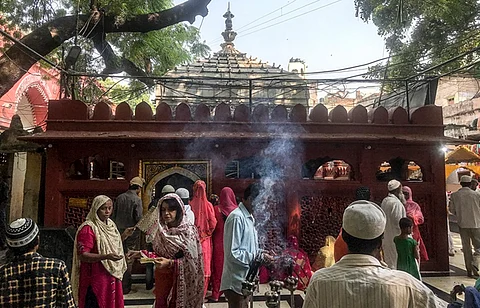

Delhi, the sprawling (and highly unwelcoming) capital of the Republic of India, is voting to elect its next government today on February 5, 2025. But even as election fever is all-pervasive, the voting is being held only a couple of days after Vasant Panchami, the Hindu festival that celebrates the arrival of Spring in North India, of which Delhi is the hub. A good time to remember a man, who not long ago, painted the beauty of Delhi (yes, it was a beautiful citadel once) in his works.
The man was Amir Khusro, an icon in the history of Medieval South Asia. His oeuvre extends from language, music and history to religion and the social sciences.
Khusro was born and lived through turbulent times. It was the mid-1200s. The political landscape of North India had changed hands barely 50 years in 1191-92, when Shahabuddin Ghori, the Ghorid Sultan, had defeated Prithviraj III, the Chauhan Rajput king of Delhi and Ajmer to establish the first Islamic foothold in the region.
Khusro was born Abul Hasan Yaminuddin Khusro or Amir Khusro in Patiali, in the modern district of Etah in Uttar Pradesh during the month of Shavval in 651 Al Hijiri as per the Islamic Calendar (1253 Common Era).
His father, Amir Saifuddin Mahmood, migrated to India from the city of Kush, presently Shehr-e-Sabz, in Central Asia, on the borders of Tajikistan and Uzbekistan.
Khusro served 10 sultans of the Delhi Sultanate, the sprawling polity that came about in the aftermath of Ghori’s win. Five Muslim dynasties—Mamluk (Slave), Khalji, Tughlaq, Sayyid and Lodhi—ruled most of the northern parts of the Indian Subcontinent from Kabul, Punjab and Sindh in the west to Bengal in the east.
Amir Khusro served sultans from the Mamluk, Khalji and Tughlaq dynasties. The 10th sultan— a man named Muhammad bin Tughlaq—had just ascended the throne when Khusro died in 1325 CE.
He is credited with inventing several instruments of Hindustani classical music like the sitar and the tabla, besides writing exhaustively. Ghazals, dohas, quartrains and masnawis flowed from his pen and have come down to us. The Hindavi or Hindustani language that he made famous—based on Delhi and western UP’s Khariboli dialect—is today used in both its standard registers, Hindi and Urdu.
The polymath lived most of his life in Delhi though he was often away on tour. Missing the city he lived in, Khusro described it in glowing terms.
“He had passed a major period of his life there and naturally he was full of praise for this city. In the introduction to his first historical masnawi, the Qiranu's-Sa- 'dain, he gives a graphic description of this great city of which the poet was justifiably proud,” S B P Nigam writes in his essay Amir Khusrau and India, part of the 1975 Indian government publication, Memorial Volume: Amir Khusrau.
Nigam adds further, “He says, “Delhi is famous the world over for being the centre of Islam and its justice. It is like a paradise in the world. It can very well be compared to the garden of Aram in Paradise. Even the holy city of Mecca becomes its eulogist when it hears the greatness of Delhi. On account of its grandeur it has become the centre of Islam. It is situated in a hilly country. Gardens surround it for two miles and the river Yamuna flows nearby. There are three cities of Delhi. Two were old and the third one is new. By old Delhi is meant the old fort and the boundary wall to the city and New Delhi is the newly founded city of Kilokhari near the river Yamuna.”
Syed Sabahuddin Abdur Rahman, in his essay Affectionate Response to the Indian Environment published in the same Memorial Volume, wrote that Khusrau loved everything Indian.
“…He liked the climate of Delhi and India also, so he wrote that if anyone tasted once the water of this country, he would never like to drink the water of Khurasan. He felt delighted to find that in Delhi flowers were seen blooming in every part of the year and its land looked full of silver and gold due to them; here green verdure was as good as of paradise; here fruits of India and Khurasan were always found in abundance; some fruits which were available here were not to be had in Khurasan. He liked the melons of Delhi very much, so he said that this was preferable to all fruits of paradise and this was as sweet as sugar.”
Yet another instance of Khusro’s high praise for Delhi has come down to us through a long letter he wrote to Ikhtiyar-ud-din, an important noble. Khusro was away with a sultan to a remote frontier. The sultan was engaged in warding off Mongol attacks (this was after all the age of Genghis Khan and his successors).
Mirza Mohammed Wahid captures the pain as well as the pride that Khusro felt at being separated from his beloved Delhi in The Life And Works Of Amir Khusrau (1935).
“ ‘My abode was’, says he, ‘The Arch of Islam, the “qibla” of the kings of the seven realms—Delhi, that twin-sister of the blessed Heaven, a tract of paradise on the surface of the earth.”
Khusro adds further: “…its green fields are bedecked with roses, and its springs are brighter than bright eyes—running waters pleasant as life, like milk flowing through sugar. The tank of the Sultan, with its colours and illuminations looks like molten silver cast into stone. Its gardens are full of pleasure-seekers, rose-cheeked beauties with pierced ears, bright as the pearls of their ear-rings. The melodies of the “ud” and the “rabab” that rise in the gardens intoxicate the trees and render the fountains drowsy…”
Such was Delhi according to Khusro. One wonders what he would have to say about his beloved city today.